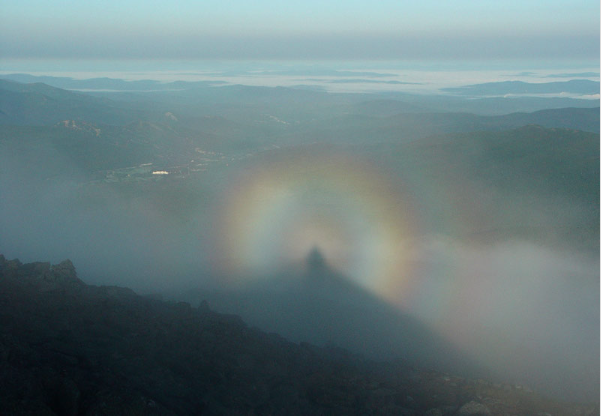Mountain glory
Mountain Glory: Exploring the Enigmatic Atmospheric Phenomenon
Have you ever witnessed a breathtaking optical display in the sky while standing atop a mountain? One such awe-inspiring phenomenon is the Mountain Glory. This mesmerizing spectacle, also known as a Brocken spectre, occurs when sunlight interacts with water droplets or ice crystals suspended in the atmosphere. While the Mountain Glory shares similarities with other atmospheric optics phenomena, it possesses unique characteristics that make it a captivating sight to behold.
Understanding the Mountain Glory
The Mountain Glory appears as a circular halo of light surrounding the observer's shadow, typically cast on a layer of mist or fog. This ethereal ring, reminiscent of a halo, is often adorned with concentric colored rings. These concentric rings, called the glory's supernumerary bows, result from the interference of light waves and can vary in number and intensity depending on atmospheric conditions.
The Science Behind the Spectacle
The formation of the Mountain Glory begins with the interaction between sunlight and tiny water droplets or ice crystals suspended in the air. When light passes through these microscopic particles, it undergoes various optical phenomena such as diffraction, refraction, and reflection. These processes contribute to the creation of the glory's characteristic concentric rings and vibrant colors.
The Role of Mist and Fog
Mist and fog play a crucial role in the formation of the Mountain Glory. When sunlight encounters these atmospheric conditions, it scatters and refracts, resulting in the creation of a bright glory around the observer's shadow. The thickness and density of the mist or fog influence the intensity and clarity of the glory, making each observation a unique and captivating experience.
Factors Affecting the Appearance of the Mountain Glory
Several factors contribute to the appearance and visibility of the Mountain Glory:
-
Sun Angle: The angle at which sunlight strikes the mist or fog affects the size and shape of the glory. Higher sun angles often result in larger and more pronounced glories.
-
Droplet Size: The size of the water droplets or ice crystals suspended in the air influences the appearance of the concentric rings and colors within the glory. Smaller droplets tend to produce more vibrant colors.
-
Observer's Position: The position of the observer in relation to the mist or fog layer determines the visibility and clarity of the glory. Being above the layer of mist or fog enhances the observer's chances of witnessing this mesmerizing phenomenon.
Capturing the Mountain Glory
Photographing the Mountain Glory can be a rewarding challenge. To capture this elusive spectacle, it is essential to consider the following tips:
-
Use a Wide-Angle Lens: A wide-angle lens allows you to capture the entire glory and its surroundings, creating a more immersive and captivating image.
-
Experiment with Exposure Settings: Adjusting your camera's exposure settings can help capture the vibrant colors and intricate details of the glory. Bracketing exposures can also be beneficial in capturing the dynamic range of the scene.
-
Choose the Right Lighting Conditions: Optimal lighting conditions, such as sunrise or sunset, can enhance the contrast and intensity of the Mountain Glory. Additionally, shooting against a dark background can make the glory more prominent in your photographs.
Mystical Legends and Cultural Significance
Throughout history, the Mountain Glory has fascinated and captivated people from various cultures. In folklore, this ethereal spectacle is often associated with mystical beings or divine intervention. Tales of mountain spirits, guardian angels, and omens have been woven around this enchanting phenomenon. Its presence has been interpreted as a sign of good fortune, protection, or even impending danger, depending on cultural beliefs.
Exploring Beyond Mountains
While the Mountain Glory is most commonly observed atop mountains, it can also manifest in other locations where mist or fog interacts with sunlight. Coastal areas, lakeshores, and even open fields with a low-lying mist can provide the perfect conditions for this ethereal spectacle. So, keep your eyes open and your camera ready, as the Mountain Glory may surprise you in unexpected places.
A Reminder of Nature's Beauty
The Mountain Glory serves as a gentle reminder of the beauty and complexity of our natural world. As we witness this captivating phenomenon, we are reminded of the intricate interplay between light, water, and atmospheric conditions. The Mountain Glory invites us to pause, marvel, and appreciate the wonders that surround us, offering a momentary escape from the chaos of everyday life.
Conclusion
The Mountain Glory, with its radiant concentric rings and vibrant colors, is a captivating atmospheric phenomenon that continues to mesmerize observers worldwide. Its formation, influenced by mist, fog, sunlight angles, and droplet size, creates a unique spectacle that defies explanation. Whether atop a mountain or in unexpected locations, witnessing the Mountain Glory is an experience that invites us to appreciate the beauty and intricacy of our natural world. So, keep your eyes to the sky and embrace the enchantment of the Mountain Glory when it graces your presence.

3-4 ringed glory from Mount Washington, New Hampshire. Jim Salge, observer at the Mount Washington Observatory,was facing west towards Bretton Woods shortly after sunrise on 3rd September 2004. "We observe Brocken spectres regularly from the station, but this morning the fog that usually enshrouds the summit was especially shallow and thin, allowing full sunlight to shine through and create a very bright glory around my shadow." ©2004 Mount Washington Observatory.
Note: this article has been automatically converted from the old site and may not appear as intended. You can find the original article here.
Reference Atmospheric Optics
If you use any of the definitions, information, or data presented on Atmospheric Optics, please copy the link or reference below to properly credit us as the reference source. Thank you!
-
<a href="https://atoptics.co.uk/blog/mountain-glory/">Mountain glory</a>
-
"Mountain glory". Atmospheric Optics. Accessed on November 26, 2024. https://atoptics.co.uk/blog/mountain-glory/.
-
"Mountain glory". Atmospheric Optics, https://atoptics.co.uk/blog/mountain-glory/. Accessed 26 November, 2024
-
Mountain glory. Atmospheric Optics. Retrieved from https://atoptics.co.uk/blog/mountain-glory/.